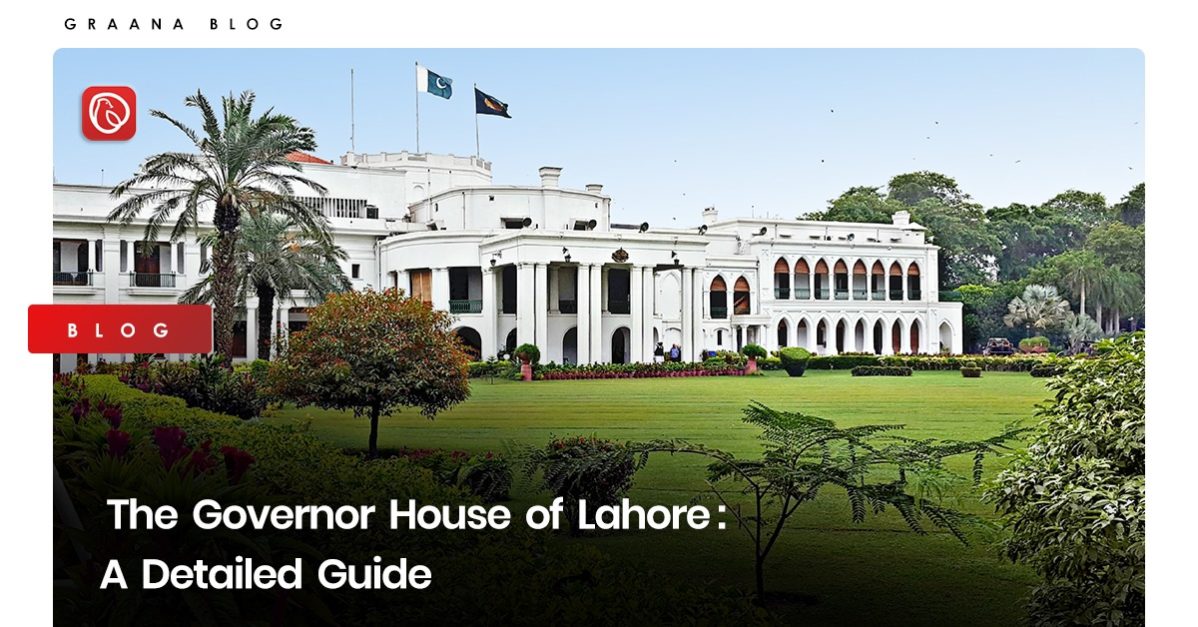
The Governer House of Lahore, also known as the Governer’s Palace, is a magnificent building that holds rich cultural and historical significance. Located in the centre of Lahore, the building is considered one of the city’s most iconic landmarks and a symbol of power and authority in the region.
The Governer House, built during the British colonial era in the late 19th century, served as the official residence of the British Governer-General of India until the 1940s.
After the partition of the subcontinent in 1947, the Governer of Punjab converted the building into his official residence. Today, it holds a ceremonial role for important state events and serves as a museum displaying the history of Lahore.
The grand architecture of the Governer House, with its lush gardens, ornate interiors, and intricate carvings, make it a popular tourist attraction and a must-visit destination for anyone interested in exploring the local heritage.
Graana.com provides a detailed overview of the Governer House of Lahore below, including its history, architecture, significance, and more.
Lord Elgin, the British Governer-General of India, initiated the construction of the Governer House of Lahore in the late 19th century during the British colonial era. The building was designed by British architect Samuel Swinton Jacob, who was renowned for his colonial-era building work in India.
Lord Elgin aimed to establish a grand residence in Lahore that reflected the power and prestige of the British Empire. In 1905, the construction of the Governer House was completed and served as the official residence of the British Governer-General of India until the 1940s.
During the British colonial era, the Governer House was the centre of political and social life in Lahore. Moreover, it was used for hosting important state events and serving as the hub of colonial administration. The building was also the site of many significant historical events. This includes the visit of King George V and Queen Mary in 1911, and the transfer of power from the British colonial administration to the newly-formed government of Pakistan in 1947.
After the partition of India in 1947, the Governer’s House became the official residence of the Governer of Punjab. The building continued to play an important role in the political and cultural life of Lahore, serving as the venue for important state events. Moreover, the first session of the National Assembly of Pakistan in 1947 was also held there.
Today, the Governer House of Lahore is a museum showcasing the nation’s history, displaying artefacts and organising exhibitions. The building is also used as a ceremonial venue for important events and as a symbol of the country’s independence and cultural heritage.
The Governer House of Lahore is a magnificent building that showcases the grand architecture of the British colonial era. Samuel Swinton Jacob drew inspiration from the Gothic and Mughal architectural styles to create a unique and imposing structure. The building is a classic example of colonial-era architecture, featuring elaborate interiors, intricate carvings, and expansive gardens.
A two-storey structure houses the main building of the Governor House, boasting a central dome that towers over the main entrance. Four smaller domes surrounded by four massive columns support the central dome.
Intricate carvings adorn the walls, depicting scenes from Hindu mythology and the lives of Mughal emperors. Two massive lions guard the entrance and symbolize power and authority.
The interior of the Governor House impresses with its spacious halls, ornate ceilings, and detailed carvings. Despite its modern amenities like air-conditioning, the building still retains its original character and charm. The main hall, known as the Durbar Hall, serves as the venue for important state events and is one of the most magnificent spaces in Lahore.
The grounds of the Governer House, with the green gardens and well-manicured lawns, provide a peaceful and serene setting for visitors. They also feature fountains, gazebos, and sculptures, making this a perfect place for a leisurely stroll or a picnic.
The tomb of Muhammad Qasim Khan is also located on the grounds of the Governer House. He was a prominent Mughal nobleman who served as the governer of Lahore during the late 17th century.
The tomb is a classic example of Mughal architecture, featuring intricate carvings, ornate tilework, and beautiful calligraphy. The tomb of Muhammad Qasim Khan is a popular spot among both locals and tourists, who visit to pay their respects to the nobleman.
For a unique dining experience, visitors can also check out the Double Decker Bus Cafe. The cafe is housed inside an old British double-decker bus, offering a unique and quirky experience.
The bus has been fully renovated and transformed into a cafe. It features comfortable seating, colourful decor, and a menu of delicious food and drinks. The cafe serves a variety of dishes, including classic British food, traditional Pakistani favourites, and others.
The government of Punjab recently allowed the Governer House of Lahore to be open to the public, allowing visitors to explore the building and learn about its history. Today it is one of the best tourist destinations in Lahore.
This decision was made as part of the government’s efforts to promote tourism and cultural heritage in Lahore.
Visitors to the Governer House can take guided tours of the building, attend the exhibitions, and learn about the nation’s past. The building also serves as a cultural centre, hosting concerts, performances, and other events.
For more relevant information, visit the Graana blog.
ISLAMABAD: Capital Development Authority (CDA) is currently undertaking a major Rs652 million project to upgrade…
Karachi – Mayor Barrister Murtaza Wahab has announced the launch of a citywide anti-encroachment operation…
ISLAMABAD: CDA Chairman Muhammad Ali Randhawa has directed the immediate restoration of 23 non-functional water…
ISLAMABAD: In a major relief for the real estate sector, the federal government has decided…
DHA Islamabad-Rawalpindi (DHAI-R), one of the most trusted names in Pakistan’s real estate landscape, is…
ISLAMABAD: Chairman Capital Development Authority (CDA), Muhammad Ali Randhawa, chaired a comprehensive review meeting on…